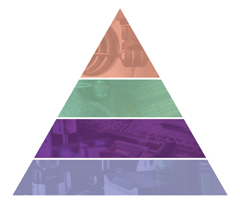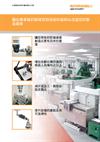製程前設定
使用測頭進行自動設定可比手動方式快達 9 倍。
Productive Process Pyramid™(金字塔生產製程解決方案)製程前設定層的控制元素在開始切削前便建立了工具機、工件與刀具之間的關係。這些自動化、預知型控制確保了首件成功率。
確保首件成功率

Productive Process Pyramid(金字塔生產製程解決方案)製程前設定層負責處理製程中的不確定因素來源,例如工件位置、刀具尺寸及機械偏置,並根據工件實際位置調整加工活動。
這些是應用於金屬切削即將開始前的預知型控制。
刀具設定可以建立
- 距離主軸量測線的長度,以確定高度補償並檢查長度是否在指定的公差範圍內
- 旋轉時的直徑,以確定刀具尺寸偏置
工件設定可以建立
- 組件識別以選擇正確 NC 程式
- 基準特徵位置,以建立工件坐標系 (WCS)
- 坯料/工件尺寸,以確定餘量狀態和粗切削順序
- 工件的方向(相對於工具機軸),以創建座標旋轉
工具機設定可以建立
- 組件定位與裝夾所需的旋轉軸、轉台或夾具組件的基準校準
- 轉台的旋轉中心位置和/或夾具元件上參考點位置
預知型控制
使用測頭進行自動設定,可比手動方式快達 9 倍,因此能夠節省出更多的時間用在金屬切削上。
測頭量測也可預知 — 您可以計算出檢測設定所需的時間,因此可以事先制定計劃。
通過機上測頭量測技術進行製程前設定時,完全由程式控制,因此不再需要專業技術人員執行多種量測、計算及輸入偏置修正等工作。
Renishaw 工件檢測測頭、刀具設定系統及 Productivity+™ 軟體是快速、自動、可重複設定金屬切削作業的重要工具。
文檔
-
 產品型錄: 生產製程控制的量測解決方案
產品型錄: 生產製程控制的量測解決方案
藉由專家級的製程控制技術的協助以改造您的製造量能
